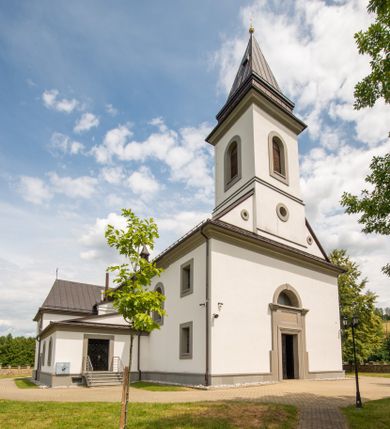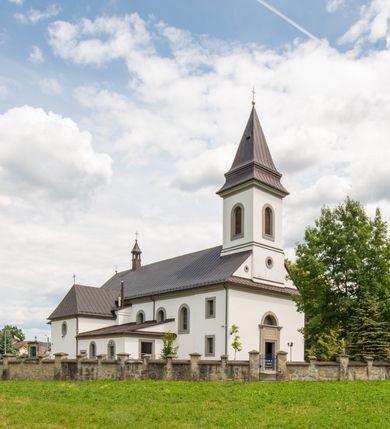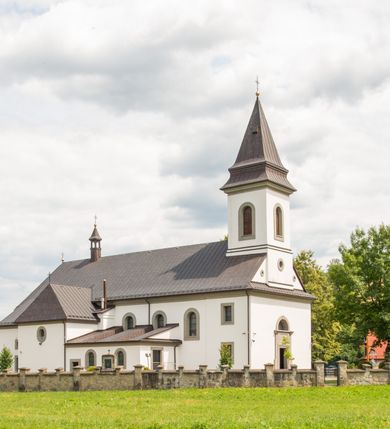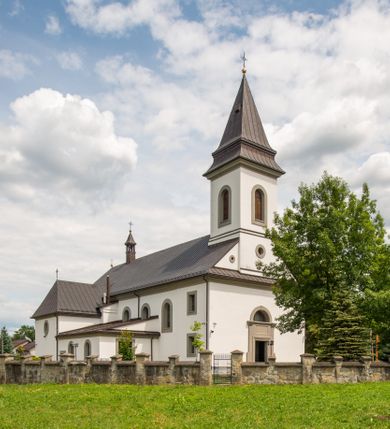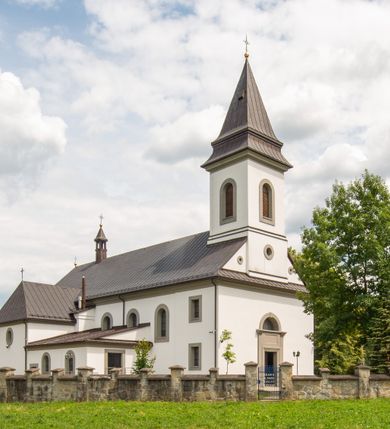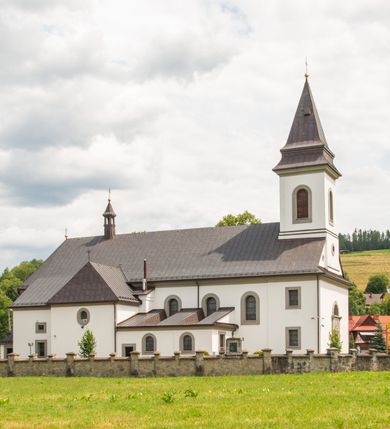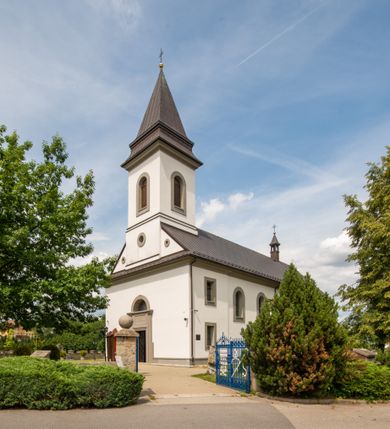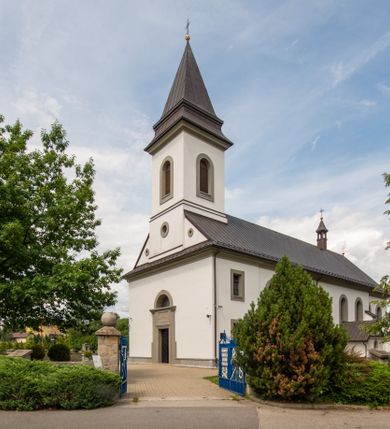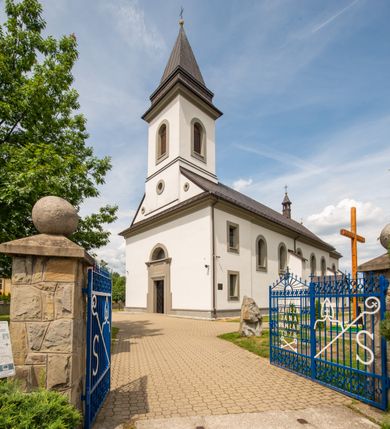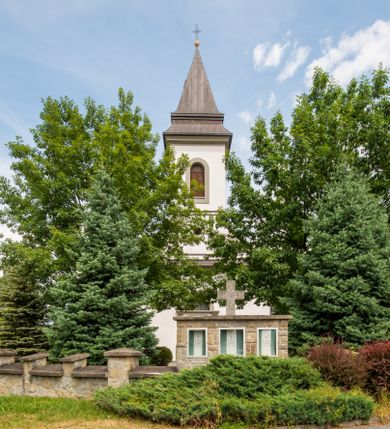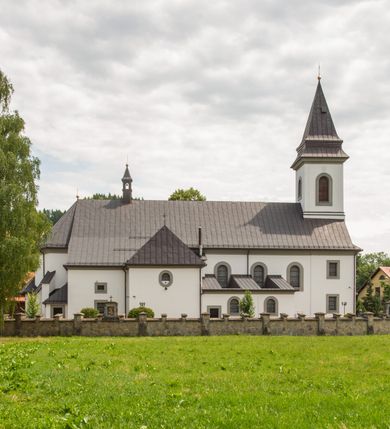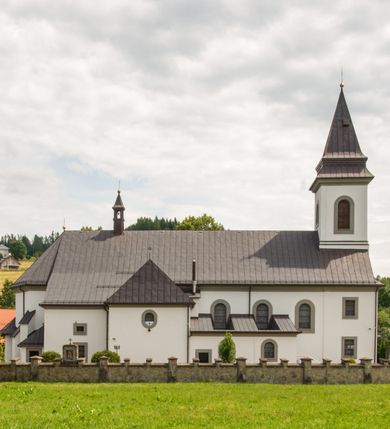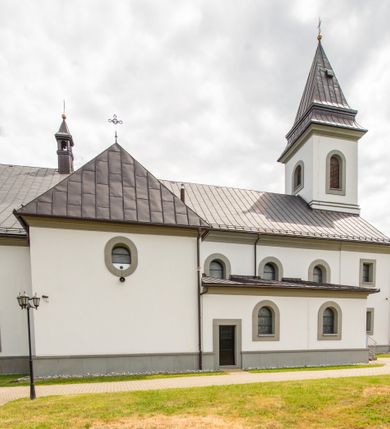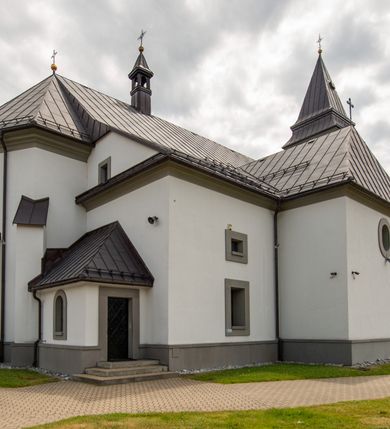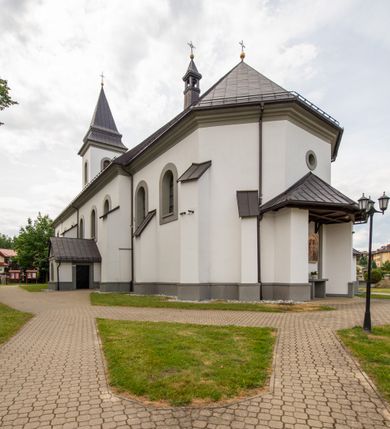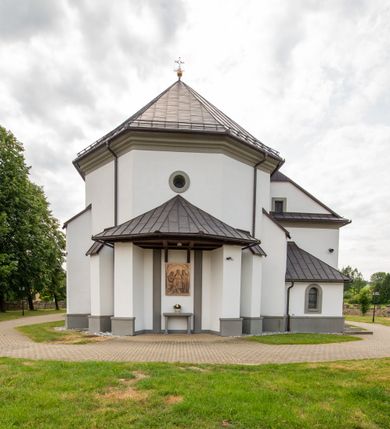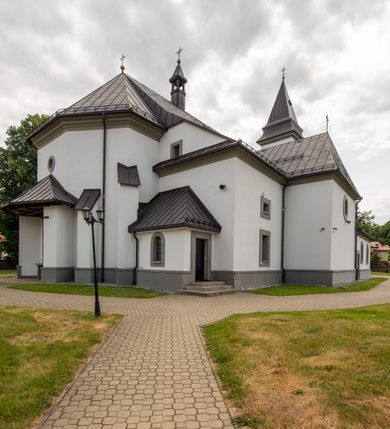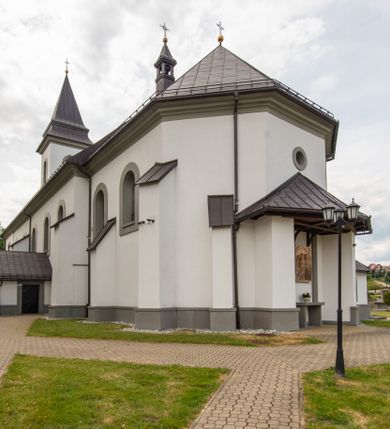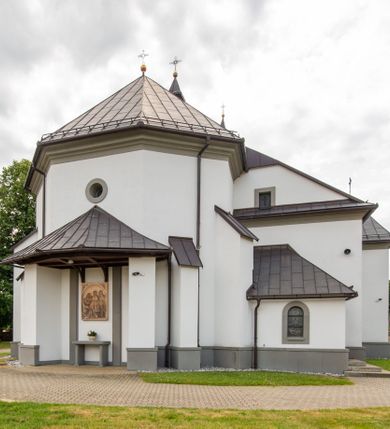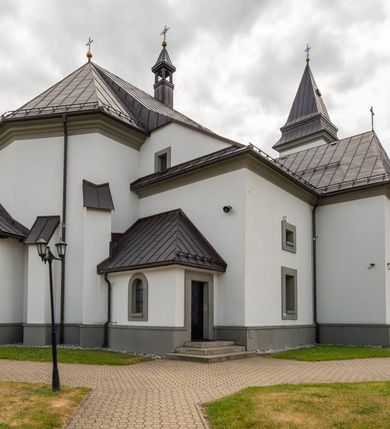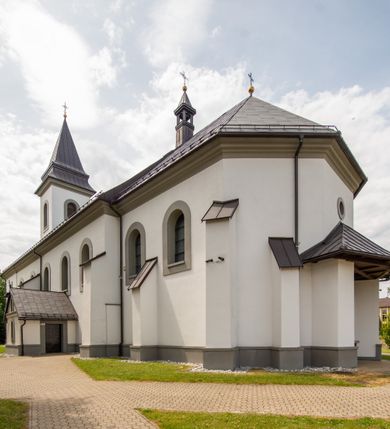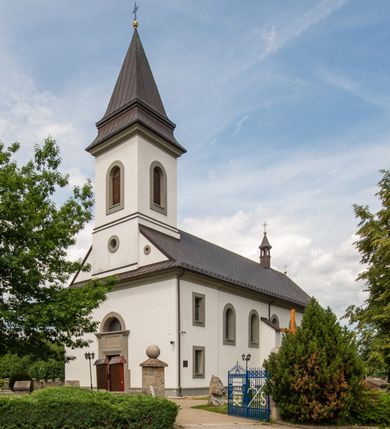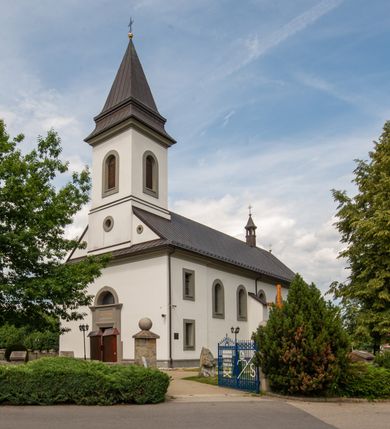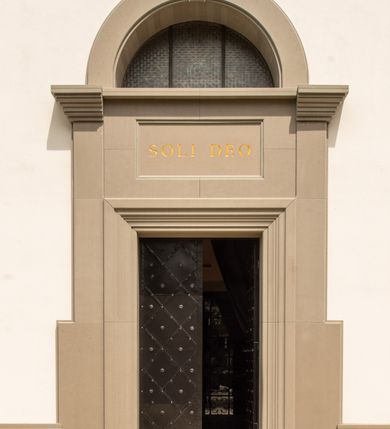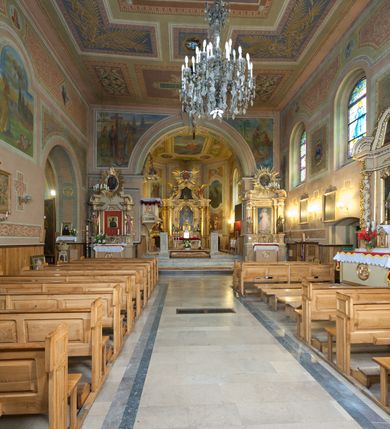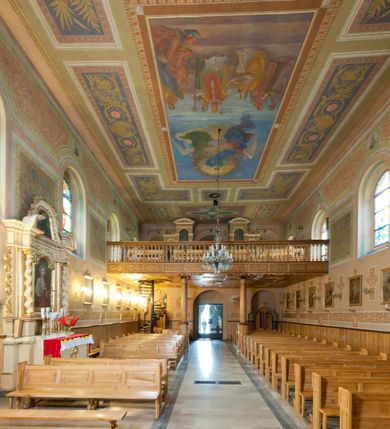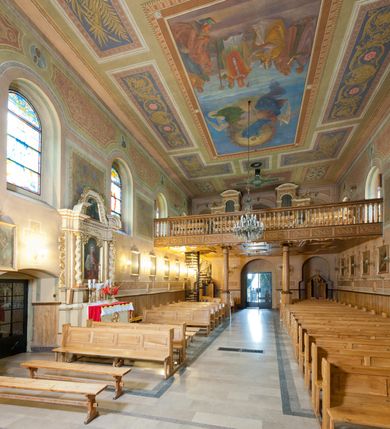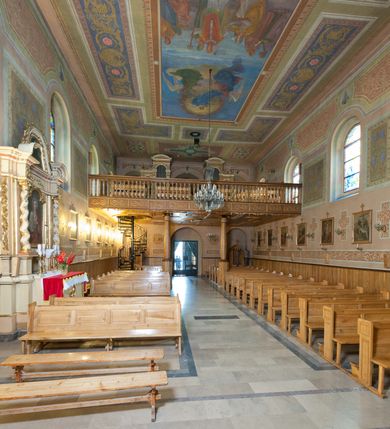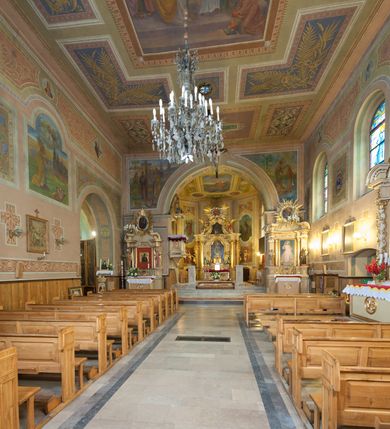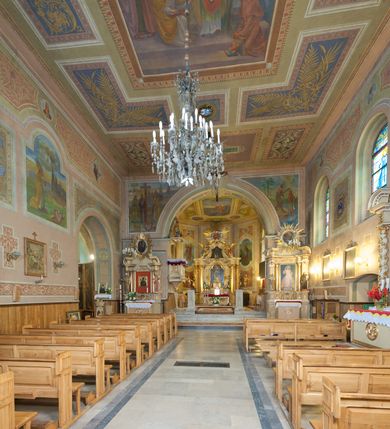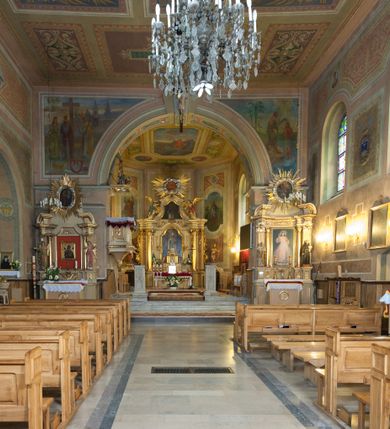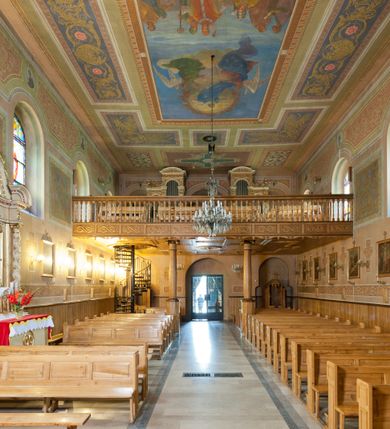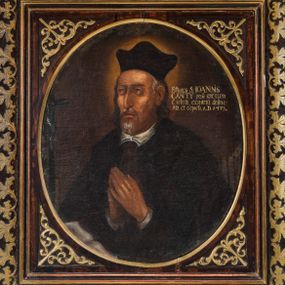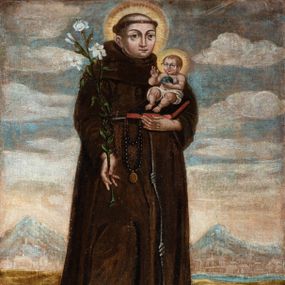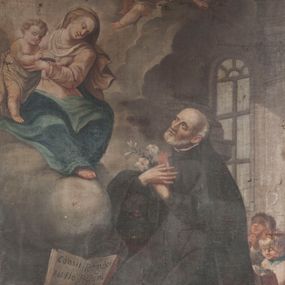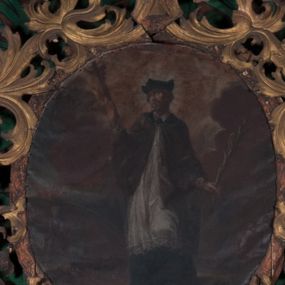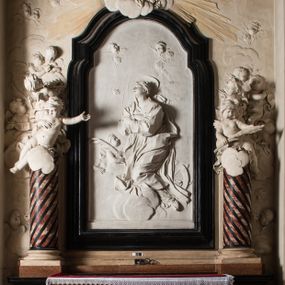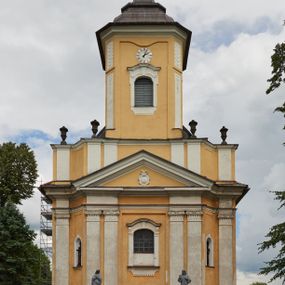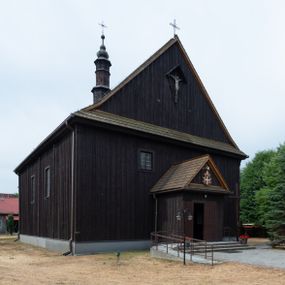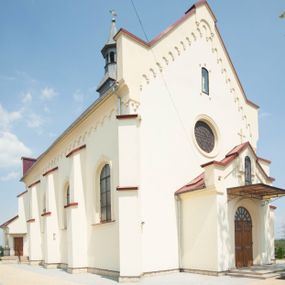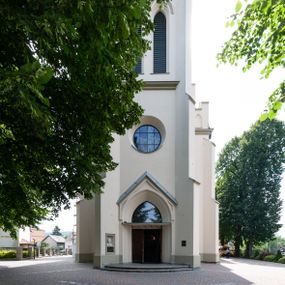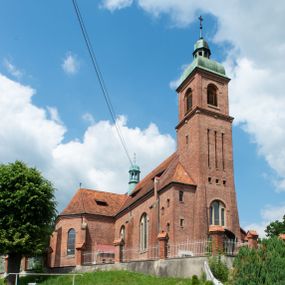
St. Stanislaus' Church
Identifier
DZIELO/12584
Amount
1
Catalogue note author
Paulina Kluz
History of work
In 1581, a wooden church was built in the then village of Raba. In the visitation records from 1596 it was noted that the church was not yet consecrated, and in the interior there were three unconsecrated altars and a wooden baptismal font. In the visitation records from 1618 it was stated that the altars were still not consecrated and the baptismal font was then made of stone.
In the 1660s a new brick church of Saint Stanislaus the Bishop and Martyr was built in Raba, and was consecrated on 14 October 1668 by the suffragan bishop from Cracow – Mikołaj Oborski. In the visitation records from 1728 the brick church was described as having a chapel, a stone floor and a wooden free-standing tower. It had five altars, including the high altar of the Crucifixion of Jesus and side altars of the Descent from the Cross, the Blessed Virgin Mary, St. Joseph and St. Anne in the chapel, as well as a stone baptismal font and a loft with an organ. Before 1765, new furnishing of the temple was made, because in the visitation records from 1765 seven altars under new invocations were mentioned, namely the high altar of the True Cross and side altars of St. Francis, St. Joseph, St. Joachim, Our Lady of the Rosary, St. Stanislaus and Our Lady of Sorrows.
In 1841-1843, the church was renovated. The building was extended on the western side by adding a façade with a tower, the old walls of the church were elevated and a new roof was built, the interior of the temple with its furnishings was painted, and new doors and windows were inserted. The church was consecrated again on 8 November 1843 by the Dean of Maków, father Marcin Leśniak. In 1856, Stefan Sariusz-Wilkoszewski, the collator of the church, funded a ridge turret covered with sheet metal. Between 1856 and 1857, through the efforts of parish priest Gottfried Fritz, the church was covered with sheet metal from the southeastern side and a floor was laid in the chapel. In 1861, two-thirds of the roof was covered with sheet metal and new pickets were put around the temple, the works on the roof were completed in 1864. The chapel was repainted in the same year on the initiative of parish priest Fritz. In 1884-1885, the attic of the church was whitewashed. In 1887, Aleksander Sowa financed 12 windowpanes for 40 forints. A year later, the roof of the church was renovated and four pillars were placed under the organ loft.
According to the account of parish priest Franciszek Kondelewicz, appointed in 1897, the church was in a poor condition. Therefore, the parish priest set up a committee which decided on the amount intended for its refurbishment. A year later, the temple was renovated from the outside, a women's gallery was added, the tower and the tin roof were restored. In 1900, the chapel and the sacristy were repainted. Also, a fence was built outside the church, in which a painted triptych was placed. In 1901, the church was covered in part with the new sheet metal, in part with the old one, patched at a cost of 125 forints. In 1902, the parish priest decided to renovate and repaint the interior of the church for the amount collected from the contributions of parishioners and from donations coming from America. First, the chancel was repainted for 700 forints, then "Mr [Piotr] Niziński, a painter under whose direction the work was carried out, persuaded me to repaint the whole church at a cost of 1900 forints. Before that, however, the walls of the church had to be cleaned and, to this end, the reed ceiling in the chancel and the nave was made, and an ornamental chancel arch was built inside, which decorated the whole temple greatly. The cost of these works was 250 forints". In 1903-1904, all the altars in the church were also repainted, and a new organ was made in 1909. A year later, the church tower was renovated and covered with eternit. In 1913, a new floor was laid at a cost of 3,000 korunas.
During the ministry of the parish priest Józef Poloński, the church was plastered in the years 1927-1932 at a cost of 400 Polish zloty, the roof on the church tower was repaired and a lightning conductor was installed for about 2,000 Polish zloty. In September 1941, the Germans took all the bells from the church. From 18 October to 6 December 1942, the authorities of that time closed the temple for the duration of the dysentery epidemic, and the religious services were then held in a manor house or in verger's house. In 1944, the church was electrified.
After the end of World War II, renovation works of the temple in Raba began. In the years 1945-1946, the roof of the temple, which was previously riddled with bullets, was repaired. In 1947, a new bell made in the Schwabe company in Biała, as well as small bells and a ridge turret were bought. In the years 1947-1950, the construction of a hoarding with altars around the church began. In 1949, the most damaged part of the roof from the side of the tower and chapel was covered with sheet metal at a cost of 169,911 zlotys. In 1951, the whole church was plastered and whitewashed from the outside at a cost of 6,400 zlotys.
In the years 1952-1961, the church was covered with new metal sheet (51,000 Polish zloty), all the windows were installed (33,000 Polish zloty), an organ loft was built (12,500 Polish zloty), electrical installation was replaced (19,000 Polish zloty), a blower for the organ was purchased (15,000 Polish zloty), installation of the telegraph network was carried out (22,000 Polish zloty), glass doors to the vestibule were bought and the organ was thoroughly renovated (12,000 Polish zloty). Most of the costs of these renovations were covered from the contributions of the countrymen living in Chicago. In 1961-1969, the interior of the chapel of Mother of God was renovated and covered with a polychrome depicting "symbolic figures in the modern spirit" made by Jerzy Gadomski. Then, the interior of the church was repainted in "celadon colour, and in warmer, pale yellow in the chancel". All the paintings in the temple were renovated and some new ones were purchased. In 1967, the construction of a hoarding around the church was completed and crowned with the construction of a field altar opposite the main entrance to the temple. The hoarding was surrounded by poplars and lime trees from without, and by rowan berries from within. Two bells "Józef" and "Stanisław" were purchased for the church. In the last years of ministry of the parish priest Józef Poloński, namely in 1969-1975, the roof was covered with silver paint, the oldest walls of the church were cleaned from the outside (sacristy, chapel and part of the chancel) and plastered at a cost of about 60,000 Polish zloty, and a quarter of the church roof was covered with new sheet metal. Also, the materials for further renovation works of the church were purchased (boards, 13 tons of lime).
Despite the constant renovation works of the church in Raba, lasting since quarter-century, in 1976 the new parish priest Wacław Heczko described the temple as tatty and destroyed. He pointed out that the roof was leaky, plasters were damp, the tower was detaching from the rest of the building, the interior was dirty, furnishings destroyed, liturgical accessories shabby, the area of the church flooded, etc... On July 12, 1976, a decision was made to renovate the temple. The works began with restoration of the tower, roof and cracked walls. On December 25, 1976, prelate Mateusz Zdebski consecrated the renovated tower, façade and sides of the temple. In 1977, a vestibule with an enclosed entrance was added to the sacristy, the previous sacristy was demolished, a new ridge turret was built, an installation of the telegraph network was carried out, the Garden of Gethsemane was renovated, new plasterwork was laid on the eastern, northern and western walls of the church and surrounded by a foil protecting it against moisture, and the stone work around the wall was completed. A year later, a new furnace for heating the church was made (consecrated on 15 October 1978), a cellar was built, the church was drained, the construction of the chapel of St. Maximilian Kolbe and Bl. Mary Theresa Ledóchowska began in place of the storage under the loft, and the church vestibule was extended. - In 1979, a major renovation of the electrical system of the church was carried out and the works on building a roof truss and covering the roof with sheet metal began and were completed a year later. In 1980, window and door joinery was made, and plasterers from Lipnica Mała started working in the interior of the temple. In 1982-1983, the loft was restored (consecrated on 5 June 1983). A year later, the church organs underwent a major renovation (and were dedicated on April 29, 1984). The whole church was covered with ash panelling in the same year. It was decided to make a new polychrome, because "the church in Raba Wyżna is very dilapidated, dirty and the altars are decayed. The 1903 polychrome by Niziński – destroyed on the ceiling. The walls are dirty and empty. The curia in Cracow, through bishop Jan Pietraszko, designated artist Jacek Konarski to create the polychrome. - A conservator in Nowy Sącz approved the polychrome designs". Works on the polychrome were carried out from 1984 to 1986 by Jacek Konarski from Krzeszowice, with the help of Józef Sas and Władysław Izdebski from Cracow. At that time, all the furnishings were repainted and a new chapel of Divine Mercy was built over the boiler room. According to the chronicle, the works lasted 20 months, and on 29 June 1986 the artists "Jacek Konarski, Gas [Sas?] and M. Chromy" left (the latter other than the artist named at the beginning of the work). After the painting of the church was completed, works on the new floor began on 19 October 1986. "The work is carried out by Eng. Nowakowski from Nowy Targ. - He examines the marble from quarries, marble from Morawica – ashy, Dębnik – black, Bolechowice – coffee. The floor was completed on April 12, 1987. In 1986-1987, five new stained glass windows were made for the church in Raba in Krzysztof Paczka's factory in Cracow (symbolic stained glass, Ascension of the Lord, Pentecost, Assumption, and Nativity). In 1988, an iron and glass grating was made for the porch and the lanterns around the church were installed at a cost of 1 350 000 zlotys. In 1988-1990, Kumorowicz from Skawa made new pews for the church. On 11 April 1990, cardinal Franciszek Macharski consecrated the polychrome, stained glass windows, floors and pews in the church in Raba. In 2011, the elevation of the temple was renovated.
Abstract
In the 1660s, a new brick church was built in Raba (consecrated on October 14, 1668 by bishop Mikołaj Oborski) in the place of the previous wooden church. In the years 1841-1843, the church was rebuilt – extended on the west side, and a facade with a tower was added. In the church in Raba, all elements of furnishings and architecture were being repaired successively from the end of World War II until 1985. The oldest preserved parts of the 17th-century church are the walls of the chancel, partly belonging to the northern and southern elevation with preserved buttresses, and the chapel. During the renovation of the temple in 1841-1843, the church was given a new architectural form referring to the Austrian Landspfarrkirche, i.e. typical churches built according to schematic official designs in the Habsburg Empire during the reforms of Maria Theresa and Joseph II.
Other works from this place
Other works from this year
Similar works
How to cite?
Paulina Kluz, "St. Stanislaus' Church", [in:] "The Sacred Lesser Poland Heritage", 2026, source: https://sdm.upjp2.edu.pl/en/works/st-stanislaus-church
